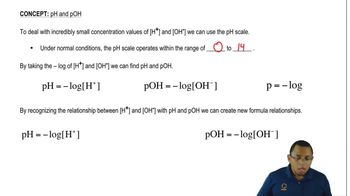Here are the essential concepts you must grasp in order to answer the question correctly.
Hydronium Ion Concentration
Hydronium ion concentration, represented as [H3O+], indicates the amount of hydronium ions present in a solution. It is a crucial factor in determining the acidity of a solution; higher concentrations correspond to more acidic solutions. In the case of bleach, the concentration is given as 1.0×10^-12 M, which suggests a low level of acidity.
Recommended video:
Percent Concentrations Concept 1
pH Scale
The pH scale quantifies the acidity or basicity of a solution, ranging from 0 to 14. A pH of 7 is considered neutral, while values below 7 indicate acidity and values above 7 indicate basicity. The pH can be calculated from the hydronium ion concentration using the formula pH = -log[H3O+]. For bleach, the low hydronium concentration will result in a high pH, indicating a basic solution.
Recommended video:
Acidic, Neutral, or Basic
This classification describes the nature of a solution based on its pH level. Solutions with a pH less than 7 are acidic, those with a pH of 7 are neutral, and those with a pH greater than 7 are basic. Understanding this classification is essential for interpreting the properties of substances like bleach, which is typically basic due to its low hydronium ion concentration.
Recommended video:
Balancing Redox Reactions: Basic Solutions

 Verified step by step guidance
Verified step by step guidance Verified video answer for a similar problem:
Verified video answer for a similar problem:



 1:31m
1:31m